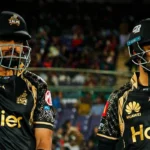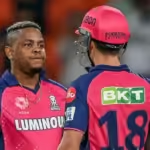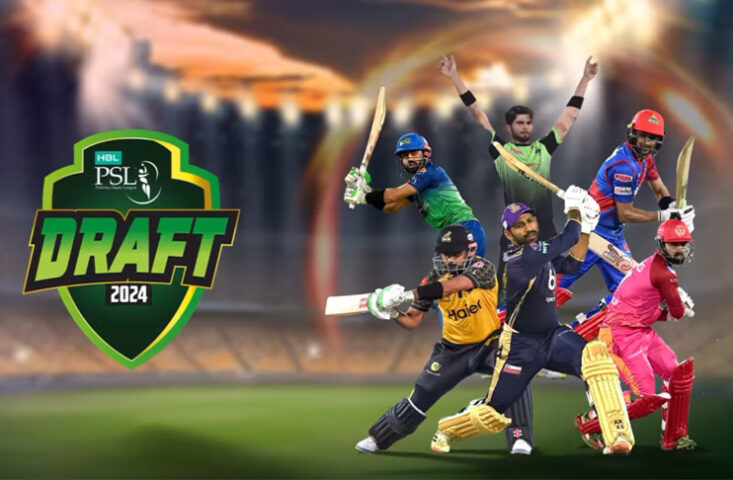
Navigating the Business of Cricket: Sponsorship and Commercial Partnerships in the Pakistan Super League (PSL)
May 16, 2024
Impact of IPL 2024 on Indian Cricket: Development and Global Influence
May 16, 2024Decoding the Player Draft and Squad Building in the Pakistan Super League (PSL)
Introduction: The Pakistan Super League (PSL) has evolved into one of cricket’s most celebrated T20 tournaments, featuring top-tier talent from around the globe. Behind the glitz and glamour of the matches lies a meticulous process of player draft and squad building, which forms the backbone of each franchise’s quest for glory. In this comprehensive exploration, we unravel the intricacies of the PSL’s player draft system and delve into the strategic maneuvers that shape the composition of teams.
Chapter 1: Understanding the Player Draft
- The significance of the player draft in the PSL ecosystem.
- Overview of the draft process, including categories, rounds, and selection mechanisms.
- Evolution of the draft system since the inception of the PSL.
Chapter 2: Categories and Player Classification
- Analysis of player categories: Platinum, Diamond, Gold, Silver, and Emerging.
- Criteria for player classification and evaluation.
- Impact of player categories on squad composition and strategy.
Chapter 3: Strategies and Tactics
- Franchise approaches to squad building: from star-studded lineups to balanced rosters.
- Tactical considerations in player selection: filling key positions, building depth, and accounting for playing conditions.
- Balancing short-term success with long-term sustainability.
Chapter 4: Balancing Experience and Youth
- The importance of blending experience with youth in squad building.
- Identifying and nurturing young talent through the Emerging category.
- Mentorship and leadership roles for senior players within the squad.
Chapter 5: Overseas Signings and Foreign Player Quotas
- Challenges and opportunities in recruiting overseas players.
- Strategies for maximizing the impact of foreign signings within league regulations.
- Balancing the allure of international stars with the need for team cohesion.
Chapter 6: Scouting and Recruitment Process
- The role of talent scouts and cricketing experts in player evaluation.
- Data-driven approaches to talent identification and analysis.
- Challenges in scouting and recruitment, including competition from other leagues and international commitments.
Chapter 7: Player Retention and Transfers
- The dynamics of player retention and transfers in the PSL.
- Factors influencing retention decisions, including performance, loyalty, and team culture.
- Impact of player transfers on squad dynamics and team performance.
Chapter 8: Team Dynamics and Chemistry
- Building team chemistry and cohesion in a diverse squad.
- Strategies for fostering a positive team culture and environment.
- The role of coaching staff and support personnel in maximizing player potential.
- Chapter 9: Challenges and OpportunitiesThe player draft and squad building process in the Pakistan Super League (PSL) are not without their challenges, but they also present numerous opportunities for innovation and improvement. In this chapter, we explore the complexities that franchises face and the potential pathways for growth and advancement.1. Governance Challenges and Regulatory Issues:
- Regulatory compliance: Ensuring adherence to league regulations and guidelines governing player recruitment, retention, and transfers.
- Transparency and accountability: Addressing concerns related to governance, ethics, and integrity in the drafting process.
- Legal complexities: Navigating contractual obligations, dispute resolution mechanisms, and player rights within the framework of league governance.
2. Opportunities for Innovation and Improvement:
- Data-driven decision-making: Leveraging analytics, performance metrics, and scouting data to inform player selection and squad building strategies.
- Talent identification programs: Establishing grassroots development initiatives and talent scouting networks to identify and nurture young cricketers.
- Collaboration and knowledge-sharing: Promoting collaboration among franchises, cricketing bodies, and industry stakeholders to share best practices and drive innovation in squad building methodologies.
3. Addressing External Factors and Uncertainties:
- Player availability: Managing uncertainties related to player availability due to international commitments, injuries, and scheduling conflicts.
- Market dynamics: Adapting to changes in player market dynamics, including fluctuating player valuations, transfer fees, and demand-supply dynamics.
- Economic challenges: Mitigating the impact of economic uncertainties, currency fluctuations, and financial constraints on franchise operations and player recruitment strategies.
4. Building Sustainable Squad Structures:
- Long-term planning: Adopting a strategic approach to squad building that balances short-term objectives with long-term sustainability and success.
- Player development pathways: Investing in player development programs, academies, and pathways to groom talent and build a pipeline of future stars.
- Roster management: Implementing effective roster management strategies to optimize squad composition, maintain salary cap compliance, and ensure roster flexibility.
Chapter 10: Future Trends and Developments
As the PSL evolves and matures, it will continue to shape the future of franchise cricket in Pakistan and beyond. In this chapter, we explore emerging trends, technological advancements, and strategic imperatives that will define the next phase of growth and development in the player draft and squad building process.
1. Technological Advancements in Talent Identification:
- AI and machine learning: Harnessing AI-powered algorithms and predictive analytics to identify talent, assess performance, and predict player potential.
- Virtual scouting platforms: Leveraging virtual scouting platforms and digital tools to conduct remote talent evaluations, assessments, and trials.
- Wearable technology: Integrating wearable technology devices and performance trackers to monitor player fitness, workload, and injury risk.
2. Evolution of Squad Building Strategies:
- Multi-dimensional scouting: Adopting a multi-dimensional approach to player scouting that considers not only on-field performance but also off-field attributes such as character, temperament, and coachability.
- Data-driven recruitment: Embracing data-driven recruitment models that prioritize statistical analysis, performance metrics, and predictive modeling in player evaluation and selection.
- Hybrid talent acquisition models: Exploring hybrid talent acquisition models that combine traditional scouting methods with advanced analytics and technology-driven insights.
3. Sustainable Development Pathways for Young Cricketers:
- Grassroots development initiatives: Investing in grassroots development programs, school cricket, and junior academies to nurture talent at the grassroots level.
- Talent identification camps: Organizing talent identification camps, talent hunts, and regional trials to identify promising young cricketers from diverse backgrounds.
- Mentorship and coaching programs: Establishing mentorship and coaching programs to provide guidance, support, and mentorship to young cricketers as they transition from junior to senior levels.
4. Globalization and International Collaboration:
- Global talent exchange programs: Facilitating international talent exchange programs, bilateral agreements, and cross-border collaborations to provide players with exposure to diverse cricketing cultures and playing environments.
- Strategic partnerships with international leagues: Forming strategic partnerships and alliances with international cricket leagues to promote talent development, player exchange, and knowledge-sharing initiatives.
- Expansion of the PSL brand: Expanding the reach and influence of the PSL brand through international franchise partnerships, overseas tournaments, and promotional initiatives.
Conclusion: The player draft and squad building process in the Pakistan Super League are dynamic and evolving, driven by a relentless pursuit of excellence and innovation. As franchises navigate the challenges and seize the opportunities presented by an ever-changing cricketing landscape, they will continue to shape the future of franchise cricket in Pakistan and contribute to the global growth and development of the sport.
- 1 .What is the player draft in the Pakistan Super League (PSL), and how does it work?
- The player draft is a process where PSL franchises select players from a pool of available talent to form their squads for the upcoming season. Franchises take turns to make selections based on predefined categories like Platinum, Diamond, Gold, and Emerging players.
2. How are players classified in the PSL draft, and what are the criteria for each category?
- Players are classified into different categories based on their skill level, experience, and potential. Categories include Platinum (top-tier international stars), Diamond, Gold, Silver, and Emerging (young domestic talents). The criteria for classification vary but generally consider players’ performance, reputation, and potential impact.
3. What strategies do franchises employ during the player draft to build their squads?
- Franchises employ various strategies such as focusing on securing top-tier talent, building a balanced squad with a mix of experienced players and emerging talents, and targeting specific positions or playing styles to address team needs.
4. How do franchises balance experience and youth when building their squads in the PSL?
- Balancing experience and youth is crucial in squad building. Franchises often aim to blend seasoned veterans who bring leadership and stability with young talents who inject vitality and enthusiasm into the team.
5. What challenges do franchises face during the player draft, and how do they address them?
- Challenges include regulatory compliance, player availability, market dynamics, and budget constraints. Franchises address these challenges through strategic planning, data-driven decision-making, and effective roster management.
6. How do franchises navigate the recruitment of overseas players within league regulations?
- Franchises have a limited number of slots for overseas players, so they must carefully strategize their foreign player selections to maximize impact while ensuring compliance with league regulations regarding foreign player quotas.
7. What role do talent scouts and cricketing experts play in the player draft process?
- Talent scouts and cricketing experts play a crucial role in player evaluation, providing insights into players’ performance, fitness, and suitability to the team’s playing style. They help franchises identify potential targets and make informed decisions during the draft.
8. How do franchises manage player retention and transfers between seasons?
- Franchises have the option to retain a certain number of players from their previous squads or engage in player transfers with other teams. Retention decisions are influenced by factors like performance, loyalty, and team culture, while transfers provide opportunities to strengthen weak areas or address specific needs.
9. What are some emerging trends and developments in the player draft and squad building process in the PSL?
- Emerging trends include technological advancements in talent identification, data-driven recruitment models, sustainable development pathways for young cricketers, and globalization through international collaborations and partnerships.
10. How does the player draft and squad building process contribute to the overall competitiveness and excitement of the PSL?
- The player draft and squad building process lay the foundation for the competitiveness and excitement of the PSL by assembling squads with diverse talents and skillsets. This ensures that each team is well-equipped to compete at the highest level and provides fans with thrilling cricketing action throughout the tournament.


